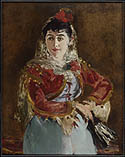Music Halls and Operas: The Class Divide in The Yellow Book
Edward-Ian Manapul
Ryerson University
2386
Music in the Victorian Era
|
The Victorian Era,
beginning from 1837 to 1901, celebrated music as an art form and as
entertainment. However, Britain never produced a composer noteworthy
enough to reach Mozart or Beethoven talent or fame (Solie 101).
Though Britain leaned towards the art side (paintings, drawings,
etc.), they were concerned of their lack of musical talent being
produced, according to Frederick Crowest (101-102), . This is more of
a shock because London was a center that attracted international
musicians and composers and made frequent returns. Additionally, the
Victorian aesthetic welcomed new musicians because of Britain's
fondness for foreign composers and they encouraged the youth to
participate and learn how to play and compose music (102). Music was
being spent as both leisure and public space (109). Despite music not
being Britain's strongest points, music was an essential aspect to
the Victorian aesthetic. It was frequently one of Britain's main
interests as entertainment through its integration in education,
music festivals, and demand for more music sheets, teachers, and
pianos (105-106). They may have not been able to produce an 'English
Beethoven' but it does not prevent Victorians from appreciating it
for all its qualities.
There was a clear divide between what was considered appropriate in between higher, middle, and lower classes. There were distinct institutions that separated the audience by their economic status: music halls and operas. Music halls were places for variety entertainment ranging from singing popular tunes and theatrical performances (Duvall 181). It was also a place for drinking low-priced alcohol with other citizens within the community (Kennedy). It has garnered the reputation of appealing to only the lower classes and as a place for moral degradation and detrimental to the working class (Duvall 181). On the other hand, operas were for middle class to upper class entertainment (Solie 110). Operas appealed to middle and upper class citizens because of their sophisticated and complex connotations. |
"The Composer of 'Carmen'"
|
Charles Willeby was an author who
wrote about the careers and works of composers of their work by the
public. His contribution to The Yellow Book was “The Composer of
'Carmen'”, a biography of Georges Bizet. This text is a posthumous
appreciation because he was unfortunately overlooked during his
career. It discusses childhood, background in music, their career
path, and the reception of his compositions. His most notable
contribution was “Carmen” which was too complex and demanding for
the audience which resulted in an outrage despite running through
forty-eight performances. “Carmen” was praised for its strong
characterization, tense drama, rich literature, and opening a new
genre of realistic opera. The text's placement in The Yellow Book can
be understood as shedding light on an overlooked composer because of
the avant-garde qualities of his work. Since “Carmen” was
revolutionary for its time, a text about the composer would interest
the upper and middle class because they were the ones watching operas
and suit The Yellow Book because it was avant-garde. It can also be
assumed Lane used the text for controversy because of its initial
reception. The title does not say 'Georges Bizet' but instead uses
“The Composer of 'Carmen'” to draw in the readers through
“Carmen” because of its popularity and infamy. Knowing that Lane
wanted to change what was popular, it can be concluded that the
inclusion of this text was to convince the audience to reevaluate
their opinions of “Carmen”. The text was used to incite
controversy to make light of a neglected and artistic composer in a
positive manner for the avant-garde value.
|

|
"The Lion Comique"

|
One
of Sickert's interests in painting were the strange angles of music
halls (Hopkins). His painting “The Lion Comique” features a lion
comique paused in action whilst two violinists appear in the
foreground. According to William Rough's analysis of Sickert's
“Little Dot Hetherington”, Sickert was interested in the duality
and artificiality of music halls. In this painting, he explores the
relationship between the singer and the audience and notes the
implied mirrors for duality. Since “The Lion Comique” was
situated in a music hall, it can be assumed that Sickert intended to
analyze the duality of the lion comique and the musicians. The irony
of the painting is that upper class men were expected to be
sophisticated which contrasts with the seriousness of the musicians
because they are not a parody of anything. He might be criticizing
the artificiality of upper class men through the lion comique because
they are portrayed as womanizing and drinking-obsessed figures as
opposed to their assumed cultured attitude. Sickert may be noting the
performance versus reality concept through these contrasts of
seriousness and parodies to blur the line between the two. The most
important aspect is that Sickert introduces an artistic and
avant-garde angle to music halls. They were also popular literary
analysis by authors such as T. S. Eliot and G. H. Mair (Duvall 181);
one being the social awkwardness of musicians whom were praised, but
were unsure of what economic class they belonged in. The
Yellow Book was intended to
bring avant-garde to the masses and music halls were not seen as
such, proving their artistic and literary value.
|



